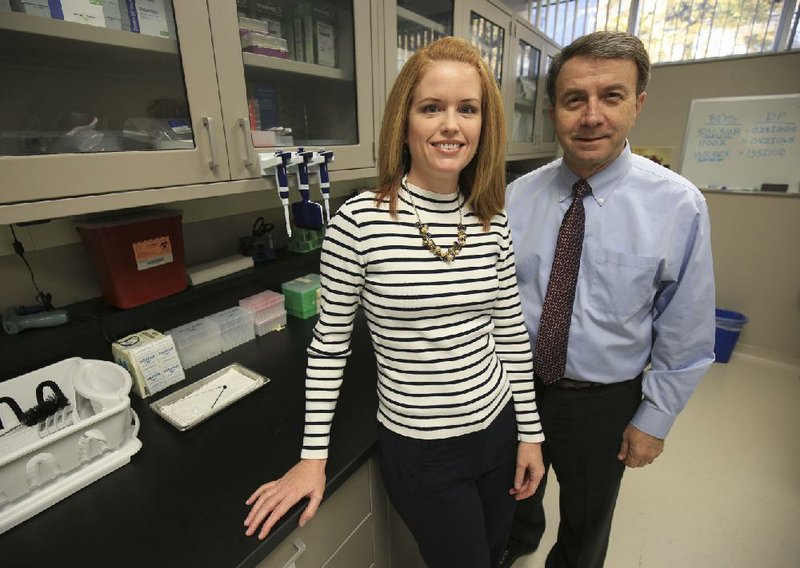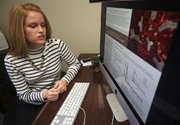About 15 years ago, Michael Owens and his team of researchers wrapped up their work inventing a medicine that targets PCP overdoses and turned their focus to a more widely used drug: methamphetamine.
With federal research money, the University of Arkansas for Medical Sciences professor and the group of researchers created a medicine that would combat meth addictions, filing patents along the way and eventually forming a company called InterveXion Therapeutics LLC in 2004 -- all with the help of UAMS BioVentures.
BioVentures opened in 1994 as an arm of UAMS that promotes and commercializes biomedical technology and new inventions.
On Jan. 1, two decades later, UAMS BioVentures turned into a 501(c)(3).
With the nonprofit status, UAMS hopes to increase its national exposure by working with a governing board of people in the industry so it can better attract investors, a move its leaders said could drive more money into Arkansas-based health care companies and, subsequently, improve the region's economic growth.
The move allows BioVentures to create a technology investment fund to provide "seed money" to bolster startup companies, said Nancy Gray, the director of UAMS BioVentures, adding that BioVentures wasn't able to do that previously as part of the university. Many investors feel more comfortable going in on an invention if the university does, too, she said.
The switch will protect the companies -- formed because of UAMS research -- from competitors and will provide a more steady stream of funding for UAMS researchers, said Jay Chesshir, president and CEO of the Little Rock Chamber of Commerce.
The new structure gives Arkansans the best opportunity to benefit from the research developed here, he said.
"That research lends itself to better outcomes: jobs, tax revenue, health and other ways for all of us living here," he said. "You go beyond the specific economic development aspects of benefit, and in the end, the research lends itself to commercialization for a healthier Arkansas and, at the same time, a healthier world."
The change comes as the academic medical center is prioritizing research growth, partly in hopes of bringing in more revenue to support its academic mission, UAMS Chancellor Dan Rahn said, and decreasing its reliance on state general revenue.
UAMS has had successful products but no "home runs," Rahn said. "We're trying because we must -- we must -- develop additional avenues for public-private partnership to support the university. We're being more deliberate in our efforts to increase our patenting and licensing activity and increase the ease with which our faculty can collaborate with private entities."
In 1980, federal legislators passed the Bayh-Dole Act -- named after sponsors U.S. Sens. Birch Bayh of Indiana and Bob Dole of Kansas -- that encouraged higher-education institutions and small businesses that make discoveries funded by federal research money to patent and commercialize them.
For UAMS, the result became improved approaches to health and health care, instead of just publication of an academic paper, Rahn said.
That law opened the door for universities to develop support services for economic development and faculty members, among other things, he said. At UAMS, the law led to the creation of BioVentures and places constraints on ways BioVentures can assist with commercialization and partnerships, Rahn said.
With BioVentures becoming nonprofit, that puts UAMS on a level playing field with institutions in other states, including the Medical University of South Carolina and the University System of Georgia, that have had similar nonprofits.
BioVentures has supported more than 20 companies -- which have attracted more than $115 million in investments and have hired more than 300 people -- and manages 210 works or inventions, according to UAMS. Inventions include Angel Eye Camera Systems, which allow parents and families to see and interact with babies in the neonatal intensive care unit, and Safe Foods Corp., which developed an antimicrobial agent to reduce food-borne illnesses and elongated the shelf life of foods.
UAMS leaders are homing in on more research, in part by continuing to recruit "world-caliber" research faculty members and retaining them, Rahn said. About one in seven faculty members -- of a total of 1,400 -- at UAMS are devoted to research.
Currently, BioVentures gets 40 invention disclosures a year and acts on between 25 and 30 of them, Gray said.
When employees think they're on to something, they will file an invention disclosure form, which goes to the BioVentures office for review. Then BioVentures considers: Is the invention patentable? Just in the United States or internationally? Is it commercially valuable?
Typically, written documents are copyrighted, while more tangible things, such as devices or molecules, are considered for patents. There are also "trade secrets," such as the recipe for Coca-Cola. A "trade secret" is for inventions that could not be patented, or, if patented, would be difficult to keep up with possible infringements, Gray said.
After determining the best way to protect the intellectual property, BioVentures then either helps the inventors form a company or, if they don't want to start a business, it will find another group to which it will license the intellectual property for further development or to work with the inventors.
Companies -- or their investors -- pay the startup costs, including research and development, while BioVentures owns the intellectual property.
Owens -- one of the co-founders of InterveXion, along with Dr. Brooks Gentry, a professor and chairman of UAMS' Department of Anesthesiology; and Ralph Henry, a professor and chairman of UA-Fayetteville's Department of Biological Sciences -- has eight patents, most of which are for different processes of the methamphetamine antibody and medicine.
"There will be patents that deal with the chemistry of what we do," he said. "They'll be patents that deal with animal testing of what we do. There will be patents about the makeup of the medicine. If you've got one patent, it's not as strong a patent-position as when it's protected from all angles."
When the group was ready to form InterveXion, BioVentures offered up a range of services, including financial and legal aid, he said.
Once the companies get off the ground, Gray said, BioVentures links them to the entrepreneurial community. As a nonprofit, BioVentures will have its own advisory and governing board, which has been the University of Arkansas System board of trustees.
"We're looking to attract board members from relevant industry so that even if their company isn't the right one, they have a connection," said Gray, who worked for 30 years in pharmaceutical and biotechnology companies before going to UAMS about two years ago.
"Interestingly enough, the CEO of Pfizer is very good friends with the CEO of Merck. We actually had one company come back to us that they were exiting the business that they had a technology for, and they provided me with names at what used to be their competitors. In spite of the fact that they're competing companies, it's a close little community."
The switch to nonprofit status will not affect Owens' company's day-to-day operation, he said, adding that it may streamline some business processes.
InterveXion is still in the trial phase with the drug. The group has proven that the medicine is safe in humans and is now testing the medicine in the presence of methamphetamine, he said.
"First you test with the medicine antibody, then the antibody in the presence of meth at lower doses," he said. "And then you go forward to people who are addicted and with problems."
Antibodies circulate in the bloodstream and will attack and neutralize the effects of what they're against, he said. Flu vaccinations create antibodies that would neutralize the shot-takers of the virus, he said.
Unlike the flu vaccination, Owens' group pre-forms the antibodies in a laboratory, he said. The antibodies will reduce the rate at which methamphetamine travels to the brain and reduce the amount that goes to the brain, he said.
The group is still testing the dosages of the medicine and the effects, but early estimates show that a person could take the medicine every three to four weeks, he said.
The medicine has been in development for some 15 years, he said.
On average, it takes about 10 years to get a market to product, Rahn said. Drugs take longer because of regulations around technologies and safety -- and a higher failure rate. Devices could take anywhere from three to five years to get to market.
UAMS doesn't collect royalties until the first product is sold, and patents expire two decades after they are first filed to begin development of the product. So, if it takes 10 years to develop a product, UAMS would collect royalties only for the remaining 10 years on the patent.
Currently, UAMS BioVentures operates with an average annual budget of just shy of $2 million, with about half coming from the academic medical center. The rest of the budget fluctuates year to year because it comes from cost recovery -- the revenue that's returned to BioVentures from licensing fees and royalties from the inventions.
Companies reimburse BioVentures for the cost of protecting the invention, but the payment terms differ depending on the company's financial means. Generally, copyright fees are cheaper than patents, which range in the hundreds of thousands of dollars depending on the number of applications and the number of countries in which the protection is sought, Gray said.
When royalties start flowing in, the inventors keep half of the earnings until the revenue reaches $200,000, according to the UA System's board policy. A small percentage goes to the system's office, while the rest is split between Rahn's office, BioVentures and the college within UAMS that developed the product.
Once revenue exceeds $200,000, the inventors' share drops to 35 percent, while the three entities split a 60 percent portion, the policy states.
UAMS is still working with the colleges' deans to spell out when the money will be transferred from the nonprofit to the colleges and what the deans can use the earnings for, such as grant programs or faculty startup funds, Gray said.
The royalty earnings ultimately end up as a wash, Rahn said.
"Across the United States, if you are expanding this activity over time on any given year in general, you're putting more in than is coming back out," he said. "So, the total budgets of the companies we've created is $20 million, we estimate. That's not within UAMS. So that's private economic development, and we have to keep investing in this in order to enable that to happen. It's part of what we do as a public university."
Metro on 01/09/2017


